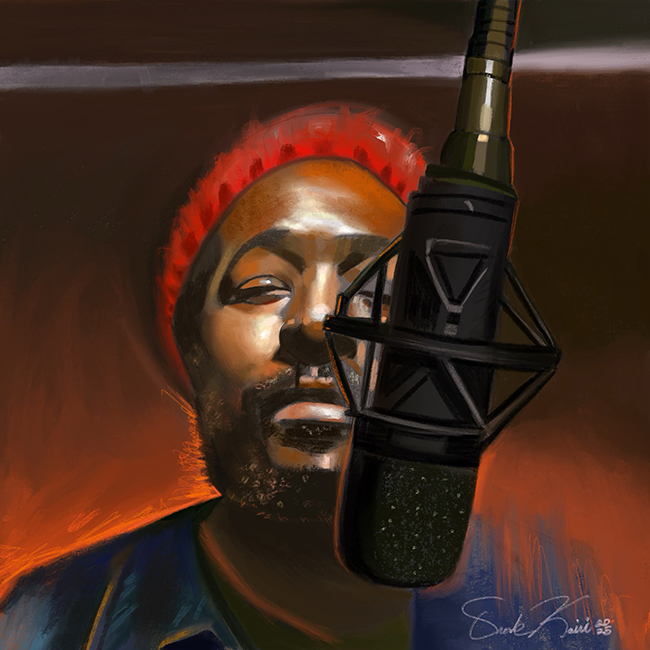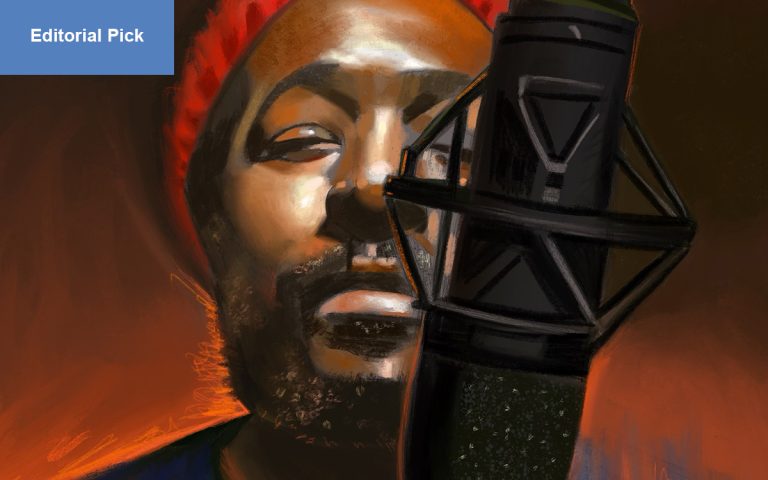Oronde Kairi works out of Germantown, Philadelphia, but his art reaches far beyond the walls of his studio. In that space—filled with rhythm, color, and memory—he brings stories to life with every brushstroke. Kairi doesn’t just paint what he sees; he paints what he hears, feels, and remembers. His work is rooted in the heartbeat of Black culture—street corners, jazz clubs, hair salons, record shops, and stoops. He turns everyday scenes into something weighty, layered, and deeply expressive. There’s music in his lines and movement in his colors. From portraits of iconic soul singers to quiet moments in Black neighborhoods, Kairi’s paintings are a record of lived experience. And like the best soul tracks, they stay with you.

One of his series, Studio Sessions, drills deep into this idea—music as memory, the studio as sacred space, and the artist as conduit. It opens with a close-up of Marvin Gaye: eyes shut, head tilted slightly forward, lost in the quiet before sound. It’s not a grand stage moment. It’s something quieter—more internal. Marvin is in his own world, not performing but becoming. The red skull cap and faded denim jacket say 1970s, but the focus isn’t nostalgia. It’s reverence. The kind of reverence you give someone about to say something true.
This isn’t a glossy image. It’s textured, lived-in. You can almost hear the low hum of the studio, the tape machine rolling, the faint rustle of paper with scribbled lyrics. The cropped framing forces you to linger. No background distractions. Just Marvin—thinking, feeling, listening before the first note.
In later pieces from Studio Sessions, Marvin moves through the space like a preacher before a sermon. There’s a shot of him at the mic, hands open, eyes still closed. Kairi doesn’t over-explain these moments. Instead, he lets the posture speak. The mic becomes more than a tool—it’s a vessel. And Marvin is not just a singer, he’s a messenger carrying something heavier than melody. Something closer to confession or prayer.
Kairi captures the gravity of this transformation—the studio as temple, the session as ritual. The colors shift depending on the mood of the moment. In one painting, deep purples and rich browns wrap around Marvin’s frame like incense smoke. In another, warm reds pulse from the floorboards, mirroring the heat in his voice. Kairi’s palette isn’t just visual—it’s emotional. Every hue is doing double duty.
There’s also a subtle commentary running underneath these images. Kairi seems to be asking us to look again at these icons—not as distant legends but as working artists. He paints the weariness in Marvin’s posture, the vulnerability of those closed eyes. He gives us a Black man in the midst of process, not product. This isn’t the Marvin of Motown glamour. It’s the Marvin of Here, My Dear—complex, raw, human.
That’s what makes Studio Sessions stand out. It’s not fan art. It’s an exploration of what it means to create while carrying weight—personal, cultural, spiritual. And it reminds us that behind every great work of music, there’s a quieter moment where it all begins. Kairi finds that moment and sits with it.
The entire series feels like a love letter—to Marvin, to music, to Black creativity in all its layers. And because Kairi keeps his focus tight, the work feels intimate, even when it’s loaded with meaning. He knows how to balance visual beauty with emotional weight. That’s not easy to do.
But it’s something Kairi has built his practice around. Whether painting street drummers in Philly or jazz legends lost in thought, his work insists on presence. It asks us to see—not just look. To feel the rhythm behind the image. To remember.
Back in his Germantown studio, the music’s always on. The colors are bold. The stories are waiting. And Oronde Kairi keeps painting what matters—one beat at a time.

